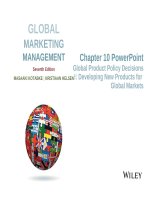Lecture Global marketing management (7th edition): Chapter 17 - Masaaki Kotabe, Kristiaan Helsen
Bạn đang xem bản rút gọn của tài liệu. Xem và tải ngay bản đầy đủ của tài liệu tại đây (3.49 MB, 27 trang )
GLOBAL
MARKETING
MANAGEMENT
Seventh Edition
MASAAKI KOTABKE | KRISTIAAN HELSEN
Chapter 17 PowerPoint
Planning, Organization, and
Control of Global Marketing
Operations
Chapter Overview
1.
2.
3.
4.
5.
6.
Global Strategic Marketing Planning
Key Criteria in Global Organizational Design
Organizational Design Options
Organizing for Global Brand Management
Life Cycle of Organizational Structures
Control of Global Marketing Efforts
Chapter 17
Copyright © 2017 John Wiley & Sons,
Inc.
2
Introduction
• The capstone of a company’s global marketing
activities will be its marketing plan.
• To implement its global plans effectively, a company
needs to reflect on the best organizational setup that
enables it to successfully meet the threats and
opportunities posed by the global marketing arena.
Chapter 17
Copyright © 2017 John Wiley & Sons,
Inc.
3
Introduction
• Global marketers must confront organizational
issues such as:
• What is the proper communication and reporting
structure?
• Who within our organization should bear responsibility
for each of the functions that need to be carried out?
• How can we as an organization leverage the
competencies and skills of our individual subsidiaries?
• Where should decision-making authority belong for the
various areas?
Chapter 17
Copyright © 2017 John Wiley & Sons,
Inc.
4
1. Global Strategic Marketing Planning
• The content of a global strategic marketing plan
usually covers four areas:
1.
2.
3.
4.
Market situation analysis
Objectives and targets
Strategies
Action plans
• Bottom-Up versus Top-Down Strategic Planning
Chapter 17
Copyright © 2017 John Wiley & Sons,
Inc.
5
1. Global Strategic Marketing Planning
• Pitfalls
Marketing plans can go wrong!
The top stumbling blocks are:
1. Lack of information of the right kind
2. Too few courses of action; too little discussion of
alternatives
3. Unrealistic objectives
4. Failure to separate short/long term plans
5. Lack of framework to identify strengths/weaknesses
6. Too many numbers
Chapter 17
Copyright © 2017 John Wiley & Sons,
Inc.
6
1. Global Strategic Marketing Planning
7. Lack of framework to define marketplace threats and
opportunities
8. Senior management de-emphasizing or forgetful
about strategic/long-range plans
9. Too little cooperation between
headquarters/subsidiaries or among subsidiaries
10. Too much information of the “wrong kind”
11. Too much planning jargon
Chapter 17
Copyright © 2017 John Wiley & Sons,
Inc.
7
2. Key Criteria in Global Organizational
Design
• Environmental Factors
–
–
–
–
Competitive Environment
Rate of Environmental Change
Regional Trading Blocs
Nature of Customers
Chapter 17
Copyright © 2017 John Wiley & Sons,
Inc.
8
2. Key Criteria in Global Organizational
Design
• Firm-Specific Factors
–
–
–
–
Strategic Importance of International Business
Product Diversity
Company Heritage
Skills and Resources within the Company
Chapter 17
Copyright © 2017 John Wiley & Sons,
Inc.
9
3. Organizational Design Options
• International Division Structure
• Global Product Division Structure
(See Exhibit 17-1.)
Chapter 17
Copyright © 2013 John Wiley & Sons,
Inc.
10
Exhibit 17-1: Organizational Structure of
Henkel:
Example of a Global Product Structure
Chapter 17
Copyright © 2017 John Wiley & Sons,
Inc.
11
3. Organizational Design Options
• Geographic Structure (Exhibit 17-2)
– Country-Based Subsidiaries
– New Role of Country Managers: Country managers of
the twenty-first century should have the following five
profiles:
•
•
•
•
•
•
Chapter 17
The trader
The builder
The cabinet member
The ambassador
The representative
The country prince (country manager and product
champion)
Copyright © 2017 John Wiley & Sons,
Inc.
12
Exhibit 17-2: Heinz Company:
Example of a Geographic Structure
Chapter 17
Copyright © 2017 John Wiley & Sons,
Inc.
13
Exhibit 17-3: Job Description of
Japan Country Manager at Twitter
Chapter 17
Copyright © 2017 John Wiley & Sons,
Inc.
14
3. Organizational Design Options
– Regional Structures
A survey done in the Asia-Pacific region singles out
five distinct roles for regional headquarters (RHQs):
•
•
•
•
•
Scouting
Strategic stimulation
Signaling commitment
Coordination
Pooling resources
• Matrix Structure (Exhibit 17-4)
– The matrix structure explicitly recognizes the
multidimensional nature of global strategic decision
making.
– With a matrix organization, two dimensions are integrated
into the organization.
Chapter 17
Copyright © 2017 John Wiley & Sons,
Inc.
15
Exhibit 17-4: Nestlé’s Organizational Setup
Chapter 17
Copyright © 2017 John Wiley & Sons,
Inc.
16
3. Organizational Design Options
• The Global Network Solution
– The networked global organization is sometimes also
referred to as a transnational.
Examples: Asea-Brown Boveri (ABB), Toyota
– In the network model, each national unit can be
viewed as a source of ideas, skills, capabilities, and
knowledge that can be harnessed for the benefit of
the total organization
(See Exhibit 17-5.)
Chapter 17
Copyright © 2017 John Wiley & Sons,
Inc.
17
Exhibit 17-5:
Guidelines on Global Virtual Teamwork
Chapter 17
Copyright © 2017 John Wiley & Sons,
Inc.
18
4. Organizing for Global Brand Management
• Global Branding Committee
– Usually made up of top-line executives from corporate
(or regional) headquarters and local subsidiaries.
• Brand Champion
– A brand champion is a top-line executive (sometimes
a CEO).
Chapter 17
Copyright © 2017 John Wiley & Sons,
Inc.
19
4. Organizing for Global Brand Management
• Global Brand Manager
To the global brand manager to be effective:
– The top of the organization is committed to branding.
– There is a solid strategic planning process in place.
– There is a need to travel to learn about local
management and best practices.
– There is a system to identify, mentor, and train
prospects who can fill the role.
• Informal, Ad-hoc Branding Meetings
Chapter 17
Copyright © 2017 John Wiley & Sons,
Inc.
20
5. Life Cycle of Organization Structures
• Companies need to adapt organizations
– existing structures too rigid or complex
– environmental changes
– managers learn new skills or new senior management
is brought in
– rethinking organizational structure
– pursuit of new strategic opportunities or directions
• Successful restructuring takes time, planning, and
resources.
• Fundamental cultural change often needed.
Chapter 17
Copyright © 2017 John Wiley & Sons,
Inc.
21
5. Life Cycle of Organization Structures
• Several management theorists attempted to devise
the “right” fit between the MNC’s environment
(internal and external) and the organizational setup.
• An in-depth study showed that the key challenge for
MNCs is building and sustaining the right
management process instead of looking for the
proper organizational structure.
• Country and regional managers must look at
strategic issues from multiple perspectives—a
“glocal” mindset.
Chapter 17
Copyright © 2017 John Wiley & Sons,
Inc.
22
Exhibit 17-6: Stopford-Wells International
Structural Stages Model
Chapter 17
Copyright © 2017 John Wiley & Sons,
Inc.
23
6. Control of Global Marketing Efforts
• Formal (“Bureaucratic”) Control Systems
– Establishing Standards (Metrics)
• Behavior- and outcome-based
– Measuring and Evaluating Performance
– Analyzing and Correcting Deviations
Chapter 17
Copyright © 2017 John Wiley & Sons,
Inc.
24
6. Control of Global Marketing Efforts
• Informal Control Methods
– Corporate Culture:
• Clan-based cultures and market-based cultures
– To shape a shared vision, cultural values should have
three properties:
• Clarity
• Continuity
• Consistency
– Human Resource Development
Chapter 17
Copyright © 2017 John Wiley & Sons,
Inc.
25









